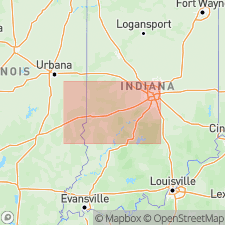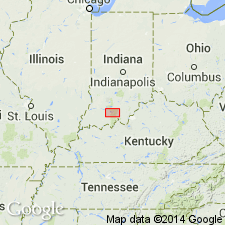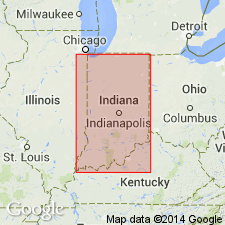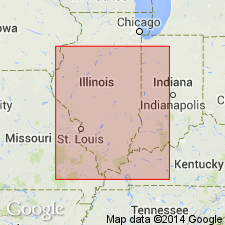
- Usage in publication:
-
- Raccoon Creek Group
- Modifications:
-
- Mapped 1:250k
- Dominant lithology:
-
- Shale
- Sandstone
- Limestone
- Clay
- Coal
- AAPG geologic province:
-
- Illinois basin
Summary:
Raccoon Creek Group. Name credited to Wier (in preparation) [Stratigraphy of the Middle and Upper Pennsylvanian rocks in southwestern Indiana, Indiana Geol. Survey Memorandum Report C-30, 172 p., 1961; revised 1965]. Mapped in western Indiana. Includes (ascending): Mansfield, Brazil, and Staunton Formations. Overlies Stephensport Group; underlies Carbondale Group. Consists of shale, sandstone, limestone, clay, and lenticular coal beds. Age is Pennsylvanian (Pottsville-Allegheny).
Source: US geologic names lexicon (USGS Bull. 1350, p. 609).

- Usage in publication:
-
- Raccoon Creek Group
- Modifications:
-
- Revised
- AAPG geologic province:
-
- Illinois basin
Summary:
Pg. 10-12. Raccoon Creek Group. Discussion of upper Patoka drainage basin. Raccoon Creek Group is about 400 feet thick, of which the uppermost 75 to 100 feet is not exposed in map area of this report. For purposes of this report the group is arbitrarily and informally subdivided into three numbered divisions. The boundaries between these divisions are the tops of the more widely traceable coal beds or the approximate position of the coal bed where the coal is absent. Top of division 2 is Mariah Hill coal. Top of division 1 is top of Pinnick coal. Division 3 is approximately equivalent to combined Brazil and Staunton Formations. Division 2 is essentially the upper part of Mansfield Formation of Gray, Jenkins, and Weidman (1960, Indiana Geol. Survey Bull., no. 20). Division 1 is lower part of Mansfield Formation in the usage of Gray, Jenkins, and Weidman (1960). Overlies unnamed group, top of which is Menard Limestone. Age is Pennsylvanian (Pottsville-Allegheny).
Source: US geologic names lexicon (USGS Bull. 1350, p. 609).

- Usage in publication:
-
- Raccoon Creek Group
- Modifications:
-
- Overview
- AAPG geologic province:
-
- Illinois basin
Summary:
Pg. 120-121, pls. Raccoon Creek Group. Includes (ascending) Mansfield, Brazil, and Staunton Formations. Consists of shale and sandstone with minor clay, coal, and limestone. Thickness from about 100 to 1,000 feet. Correlates with McCormick Group and lower Kewanee Group in Illinois, and with Caseyville, Tradewater, and lower part of Carbondale Formations in Kentucky. Underlies Carbondale Group; overlies Middle Devonian to Upper Mississippian rocks. Age is Early to Middle Pennsylvanian (Morrowan, Atokan, and Desmoinesian). Report includes map of type sections-localities-areas, correlation chart.
Indiana geologists consider type locality [area] to be along Raccoon Creek, in T. 14 N., R. 5, 6, 7, and 8 W., and T. 15 N. R. 8 W., southern Parke Co., southwestern IN, and credit name to C.E. Wier (Stratigraphy of the Middle and Upper Pennsylvanian rocks in southwestern Indiana, Indiana Geol. Survey Memorandum Report C-30, 172 p., 1961; revised 1965).
Source: Publication.

- Usage in publication:
-
- Raccoon Creek Group
- Modifications:
-
- Revised
- Areal extent
- AAPG geologic province:
-
- Illinois basin
Summary:
Pg. 2 (fig. 1), 3-4, pl. 1. Raccoon Creek Group. Extended into Illinois and Kentucky and revised to include Caseyville and Tradewater Formations. In Indiana, includes (ascending) Mansfield, Brazil, and Staunton Formations. Extends from unconformity at base of Pennsylvanian (=Kaskaskia and Absaroka cratonic sequence boundary) to base of Seelyville Coal Member, or Davis Coal Member (Davis coal bed), of Carbondale Formation. Age is Early to Middle Pennsylvanian. Classification proposed in this report agreed upon by State Geological Surveys of Illinois, Indiana, and Kentucky.
Reference sections:
(1) lower part, Mansfield Formation (subsurface), Indiana Geological Survey drillhole SDH-31, in NE/4 NE/4 sec. 3, T. 14 N., R. 7 W., and composite section of core from SDH-30 and SDH-174, in SE/4 SW/4 sec. 31, T. 15 N., R. 6 W (H.C. Huchison, 1976, Indiana Geol. Survey Bull., no. 54, p. 26-27, 52-57);
(2) upper part (from top of Raccoon Creek down to upper part Mansfield Formation, subsurface): Indiana Geol. Survey drillhole SDH-33 (S.A. Friedman, 1989, Indiana Geol. Survey Spec. Rpt., no. 42 (Open-file Rpt.)).
Cores archived in the Indiana Geological Survey core library.
Source: Publication.
For more information, please contact Nancy Stamm, Geologic Names Committee Secretary.
Asterisk (*) indicates published by U.S. Geological Survey authors.
"No current usage" (†) implies that a name has been abandoned or has fallen into disuse. Former usage and, if known, replacement name given in parentheses ( ).
Slash (/) indicates name conflicts with nomenclatural guidelines (CSN, 1933; ACSN, 1961, 1970; NACSN, 1983, 2005, 2021). May be explained within brackets ([ ]).

